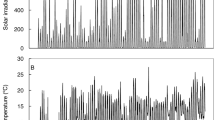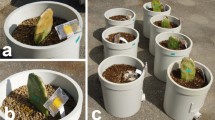Abstract
Antarctic plants are exposed to high light and low temperature during their natural growing season. Therefore, the maintenance of an oxidative status compatible with normal metabolism is an important determinant for their survival. We hypothesized that Colobanthus quitensis, the only dicotyledonous plant from the Antarctic, has efficient energy-dissipating mechanisms, and/or high antioxidant capacity. A short time treatment (24 h) of high light and/or low temperature reduced maximum photochemical quantum yield (Fv/Fm), photochemical quenching (qP), and the quantum yield of PSII (ΦPSII). Concomitantly, an increase in the nonphotochemical quenching (qN) was observed. Superoxide dismutase (SOD) activity increased after cold acclimation. High light and low temperature did not significantly affect SOD, ascorbate peroxidase (APx), and glutathione reductase (GR) in nonacclimated plants. Total soluble antioxidants and carotenoids decreased after cold acclimation. Thus, it is likely that the main mechanism of C. quitensis to cope with energy imbalance is heat dissipation, as evidenced by the great increase in qN.



Similar content being viewed by others
References
Alberdi M, Bravo LA, Gutiérrez A, Gidekel M, Corcuera LJ (2002) Ecophysiology of Antarctic vascular plants. Physiol Plant 115:479–486
Alscher RG, Donahue JL, Cramer CL (1997) Reactive oxygen species and antioxidants: relationships in green cells. Physiol Plant 100:224–233
Anderson JV, Chevone BI, Hess JL (1992) Seasonal variation in the antioxidant system of eastern white pine needles. Plant Physiol 98:501–508
Anderson MD, Prasad TK, Martín BA, Stewart CR (1994) Differential gene expression in chilling-acclimated maize seedlings and evidence for the involvement of abscisic acid in chilling tolerance. Plant Physiol 105:331–339
Bowler C, Fluhr R (2000) The role of calcium and activated oxygens as signals for controlling cross-tolerance. Trends Plant Sci 5:241–246
Bravo LA, Ulloa N, Zúñiga GE, Casanova A, Corcuera LJ, Alberdi M (2001) Cold resistance in Antarctic angiosperms. Physiol Plant 111:55–65
Cogdell RJ, Frank HA (1987) How carotenoids function in photosynthetic bacteria. Biochim Biophys Acta 895:63–79
Donahue JL, Okpodu CM, Cramer CL, Grabau EA, Alscher RG (1997) Responses of antioxidants to paraquat in pea leaves. Plant Physiol 113:249–257
Edwards JA, Lewis-Smith RI (1988) Photosynthesis and respiration of Colobanthus quitensis and Deschampsia antarctica from the Maritime Antarctic. Br Antarct Surv Bull 81:43–63
Eskling M, Emanuelsson A, Ǻkerlund H-E (2001) Enzyme and mechanism for violaxanthin-zeaxanthin convertion. In: Aro E-M, Anderson B (eds) Regulation of photosynthesis. Advances in photosynthesis, vol 11. Kluwer, Dordrecht
Fink RC, Scandalios JG (2002) Molecular evolution and structure-function relationships of the superoxide dismutase gene families in angiosperms and their relationship to other eukaryotic and prokaryotic superoxide dismutases. Arch Biochem Biophys 399:19–36
Foyer CH, Halliwell B (1976) The presence of glutathione and glutathione reductase in chloroplasts: a proposed role in ascorbic acid metabolism. Planta 133:21–25
Foyer CH, Lelandais M, Kunert KJ (1994) Photooxidative stress in plants. Physiol Plant 92:696–717
Fryer MJ, Oxborough K, Mullineaux PM, Baker NR (2002) Imaging of photo-oxidative stress responses in leaves. J Exp Bot 53:1249–1254
Grant JJ, Loake GJ (2000) Role of reactive oxygen intermediates and cognate redox signaling in disease resistance. Plant Physiol 124:21–29
Huner NPA, Ivanov AG, Wilson KE, Miskiewicz E, Krol M, Öquist G (2002) Energy sensing and photostasis in photoautotrophs. In: Storey KB, Storey JM (eds) Sensing, signaling and cell adaptation, chapter 17. Elsevier, Amsterdam
Inzé D, Van Montagu M (1995) Oxidative stress in plants. Curr Opin Biotech 6:153–158
Kaiser WM (1987) Effects of water deficits on photosynthetic capacity. Physiol Plant 71:142–149
Kimura M, Yoshizumi T, Manabe K, Yamamoto YY, Matsui M (2001) Arabidopsis transcriptional regulation by light stress via hydrogen peroxide-dependent and -independent pathways. Genes Cells 6:607–617
Krinsky NI (1989) Antioxidant functions of carotenoids. Free Radic Biol Med 7:617–635
Lichtenthaler HK, Wellburn AR (1983) Determinations of total carotenoids and chlorophylls a and b of leaf extracts in different solvents. Biochem Soc Trans 603:591–592
Maxwell K, Johnson GN (2000) Chlorophyll fluorescence—a practical guide. J Exp Bot 51:659–668
McCord JM, Fridovich I (1969) Superoxide dismutase. An enzymic function for erythrocuprin (hemocuprin). J Biol Chem 224: 6049–6055
Mishra NP, Mishra RK, Singhal GS (1993) Changes in the activity of anti-oxidant enzymes during exposure of intact wheat leaves to strong visible light at different temperatures in the presence of protein synthesis inhibitors. Plant Physiol 102:903–910
Müller P, Li X-P, Niyogi KK (2001) Non-photochemical quenching. A response to excess of light energy. Plant Physiol 125:1558–1566
Omran RG (1980) Peroxide levels and the activities of catalase, peroxidase and idoleacetic acid oxidase during and after chilling cucumber seedlings. Plant Physiol 65:407–408
Palozza P, Krinsky NI (1992) Antioxidant effects of carotenoids in vivo and in vitro: an overview. Methods Enzymol 213:403–420
Perl A, Perl-Treves R, Galili S, Aviv D, Shalgi E, Malkin S, Galun E (1993) Enhanced oxidative stress defence in transgenic potato expressing tomato Cu,Zn superoxide dismutases. Theor Appl Genet 85:568–576
Prasad TK, Anderson MD, Martin BA, Stewart CR (1994) Evidence for chilling-induced oxidative stress in maize seedlings and a regulatory role for hydrogen peroxide. Plant Cell 6:65–74
Rajguru S, Banks S, Gossett D, Lucas MC (1999) Antioxidant response to salt stress during fiber development in cotton ovules. J Cotton Sci 3:11–18
Rao MV, Gopinadhan P, Ormrod DP (1996) Ultraviolet-B- and Ozone-induced biochemical changes in antioxidant enzymes of Arabidopsis thaliana. Plant Physiol 110:125–136
Salin ML (1987) Toxic oxygen species and protective systems of the chloroplast. Physiol Plant 72:681–689
Scandalios JG (1993) Oxygen stress and superoxide dismutases. Plant Physiol 101:7–12
Schöner S, Krause GH (1990) Protective systems against active oxygen species in spinach: response to cold acclimation in excess light. Planta 180:383–389
Schreiber U, Schliwa W, Bilger U (1986) Continuous recording of photochemical and non-photochemical chlorophyll fluorescence quenching with a new type of modulation fluorimeter. Photosynth Res 10:51–62
Stajner D, Milic N, Lazic B, Mimica-Dukié N (1998) Study on antioxidant enzymes in Allium cepa L. and Allium fistulosum L. Phytother Res 12:s15–s17
Stieger PA, Feller U (1997) Degradation of stromal proteins in pea (Pisum sativum L.) chloroplasts under oxidizing conditions. J Plant Physiol 151:556–562
Tsang EWT, Bowler C, Hérouart D, Van Camp W, Villarroel R, Genetello C, Van Montagu M, Inzé D (1991) Differential regulation of superoxide dismutases in plants exposed to environmental stress. Plant Cell 3:783–792
Un-Haing C, Jung-O P (2000) Mercury-induced oxidative stress in tomato seedlings. Plant Sci 156:1–9
Xiong FS, Ruhland CT, Day TA (1999) Photosynthetic temperature response of the Antarctic vascular plants Colobanthus quitensis and Deschampsia antarctica. Physiol Plant 106:276–286
Xiong FS, Mueller EC, Day TA (2000) Photosynthetic and respiratory acclimation and growth response of Antarctic vascular plants to contrasting temperature regimes. Am J Bot 87:700–710
Yu Q, Rengel Z (1999) Micronutrient deficiency influences plant growth and activities of superoxide dismutases in narrow-leafed lupins. Ann Bot 83:175–182
Acknowledgments.
Support of FONDECYT 1010899 is gratefully acknowledged
Author information
Authors and Affiliations
Corresponding author
Rights and permissions
About this article
Cite this article
Pérez-Torres, E., Dinamarca, J., Bravo, L.A. et al. Responses of Colobanthus quitensis (Kunth) Bartl. to high light and low temperature. Polar Biol 27, 183–189 (2004). https://doi.org/10.1007/s00300-003-0577-x
Received:
Accepted:
Published:
Issue Date:
DOI: https://doi.org/10.1007/s00300-003-0577-x




